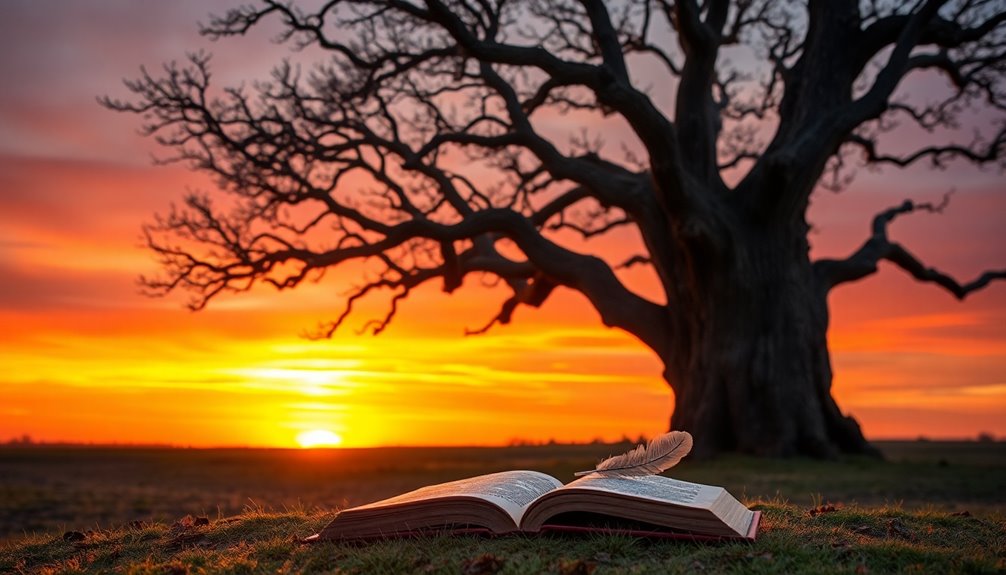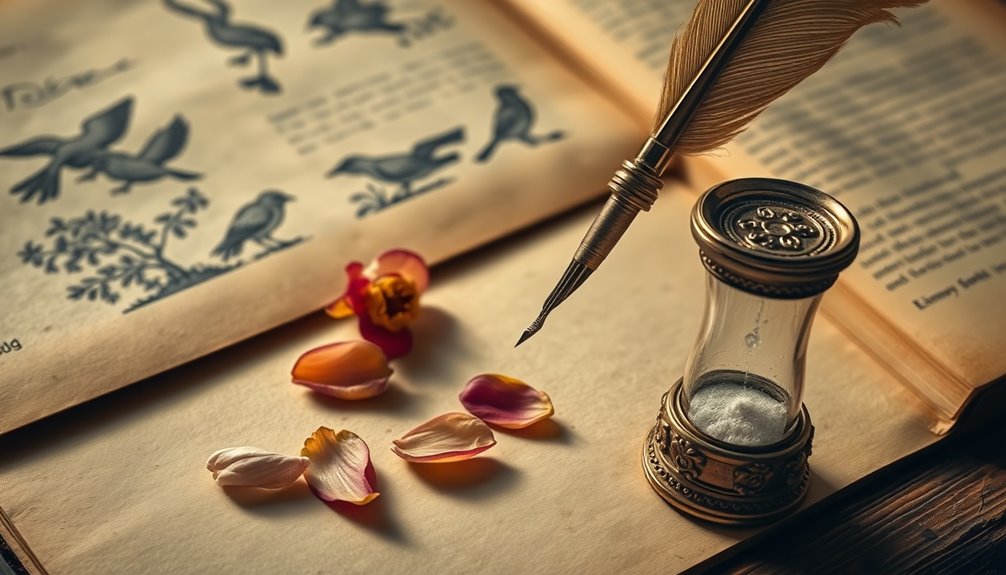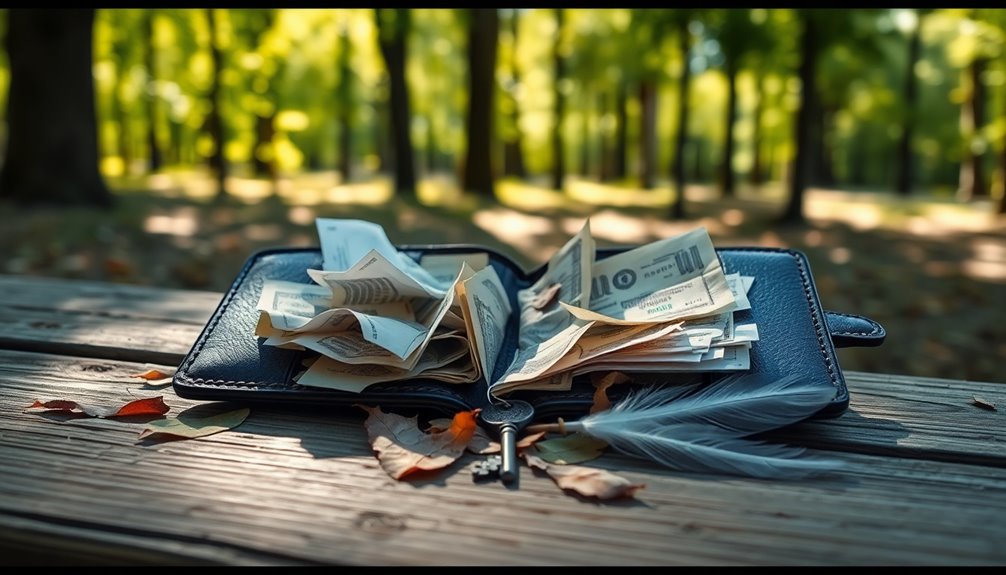Yes, symbolism is definitely a literary technique! It helps writers convey bigger ideas and themes through symbols, like objects or colors, that represent deeper meanings. When you spot a symbol in a story, it can make you feel more connected to the characters and their journeys. For example, a red rose might symbolize love, while a stormy sky could mean trouble. This technique also encourages you to think critically and interpret the messages behind the words. Exploring symbolism can reveal layers of meaning, and there's so much more waiting for you to discover!
Key Takeaways
- Symbolism is a literary technique that represents larger ideas through concrete images, enriching narratives and themes.
- Authors use symbolism to convey emotional depth and complex themes, fostering connections between readers and characters.
- Different types of symbolism, including religious and color symbolism, enhance storytelling by evoking specific emotions and meanings.
- Recognizing and analyzing symbolism in texts can significantly deepen the reader's understanding and engagement with the narrative.
- Symbolism allows for multiple interpretations, making it a powerful tool for exploring abstract ideas in literature and music.
Understanding Symbolism

When you plunge into the world of literature, understanding symbolism can greatly enhance your reading experience. Symbolism is a special technique where objects, characters, or events represent bigger ideas. Imagine reading *To Kill a Mockingbird* and realizing that the mockingbird symbolizes innocence. This adds emotional impact to the story, making you feel more connected to the characters and their journeys.
Effective symbolism can be easy to spot or more subtle, waiting for you to uncover its meaning. It's like a treasure hunt! For example, in *The Great Gatsby*, the green light represents unattainable dreams. By grasping these symbols, you open the door to deeper understanding of the text.
When you engage with symbols, you also sharpen your critical thinking skills. You start to see how authors weave deeper messages into their stories, revealing themes that might surprise you.
Historical Use of Symbolism
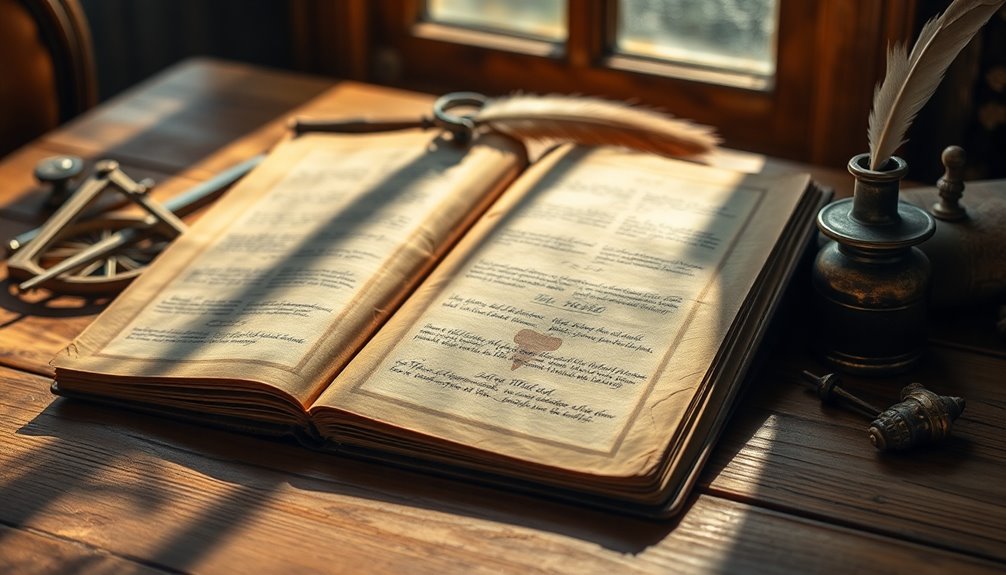
Throughout history, symbolism has played an essential role in storytelling, evolving from ancient cave paintings to modern literature. You might be surprised to learn that early humans used symbols to share their ideas and stories. For instance, cave paintings depicted animals or hunting, while hieroglyphics told complex tales of ancient Egypt.
In Ancient Greek theater, props became symbols that represented deeper themes, helping audiences connect with the emotions portrayed on stage. During the Middle Ages, religious symbols emerged, conveying spiritual lessons through art and literature. The Renaissance brought a renewed focus on human experiences, with writers like Shakespeare and Blake using symbolism to explore desires and complexities.
Here's a quick look at some key examples of symbolism throughout history:
| Time Period | Symbols Used | Examples of Symbolism |
|---|---|---|
| Ancient Times | Cave paintings | Hunting scenes |
| Greek Theater | Props | Masks representing emotions |
| Middle Ages | Religious imagery | Crosses and doves |
| Renaissance | Nature and emotions | Roses for love |
Understanding the historical use of symbolism enriches your appreciation of literature and storytelling!
Types of Symbolism in Literature

Now that we've explored the historical use of symbolism, let's look at the different types of symbolism in literature!
You'll find that religious symbolism often teaches us important lessons, while emotional symbolism helps us understand feelings through objects and actions.
Plus, color symbolism can make stories come alive, showing us how colors express deep emotions, so let's jump in and see how these symbols work together!
Religious Symbolism Examples
Religious symbolism plays a significant role in literature, allowing authors to convey complex spiritual themes and beliefs through various symbols. For example, in C.S. Lewis's *The Lion, the Witch and the Wardrobe*, Aslan represents Christ and sacrifice, giving readers a deeper understanding of love and redemption. This is a great example of symbolism that has religious connotations, showing meaning beyond its literal interpretation.
In John Milton's *Paradise Lost*, Satan symbolizes rebellion against God, exploring temptation and the struggle of free will. Dostoevsky's character Alyosha in *The Brothers Karamazov* serves as a powerful symbol of faith and moral integrity, highlighting the battle between belief and doubt.
You'll often find the cross in literature, symbolizing redemption and the promise of eternal life, reflecting core Christian beliefs.
Romantic poets like William Blake used symbols like the lamb to represent innocence, bridging nature and spirituality. Each of these symbols enriches the story, inviting you to explore profound ideas about faith, sacrifice, and the human experience.
Emotional Symbolism Exploration
Exploring emotional symbolism in literature reveals how physical symbols can effectively represent complex emotions, enriching the reader's experience. Authors like W.B. Yeats and Seamus Heaney masterfully use emotional symbolism to deepen your connection with their characters and themes.
By showing rather than telling, they engage your feelings and provoke thoughtful reflection.
Here are some examples that create vivid imagery:
- A character's tattered coat representing their struggle and loss
- A wilting flower symbolizing fading hope and love
- A stormy sky reflecting inner turmoil and conflict
- An empty chair evoking feelings of absence and longing
These symbols help you understand the emotional states of characters, adding layers of meaning to the story.
For instance, in Shakespeare's Macbeth the blood spot symbolizes guilt, while the green light in *The Great Gatsby* represents unattainable dreams.
When you recognize these symbols, you see more than just words on a page. You feel the emotions, and that makes the story come alive!
Emotional symbolism enriches literature, inviting you to explore the depths of human experience with joy and curiosity.
Color Symbolism Significance
Throughout literary history, color symbolism has emerged as a powerful tool for conveying deeper meanings and emotions. Imagine reading a story where colors jump off the page, helping you feel what the characters feel. For instance, red often symbolizes passion or anger, making you feel the intensity of a scene.
In *The Great Gatsby*, the green color represents Gatsby's dreams and the challenges of the American Dream, showing how complex life can be.
The use of symbolism with colors can also show different themes. Black might symbolize death or mourning, while white often stands for purity or innocence. These colors create strong contrasts, helping you understand the characters better.
Plus, colors can mean different things in different cultures. In the U.S., yellow brings joy, but in Japan, it stands for courage.
Importance of Symbolism in Writing
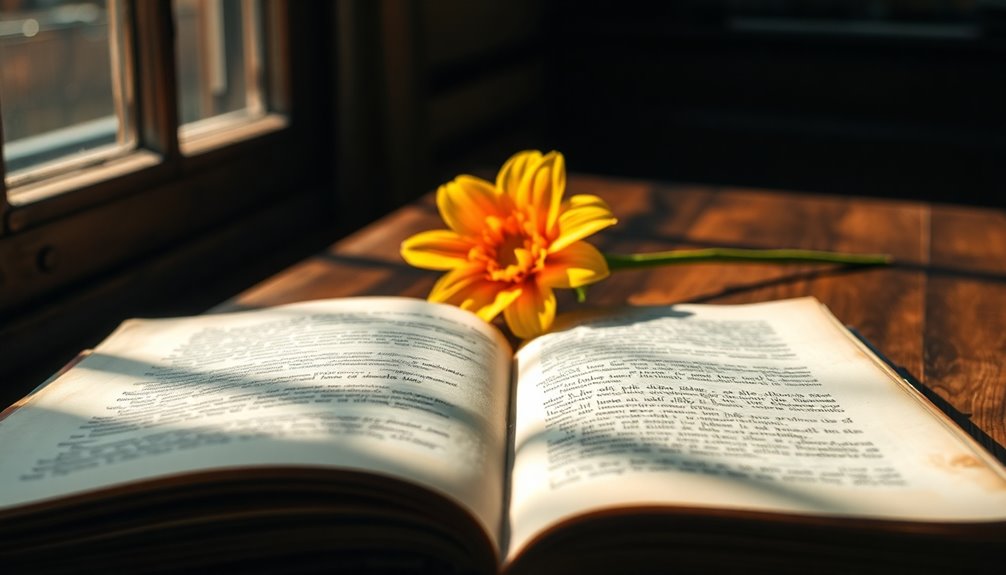
Symbolism is super important in writing because it helps you feel more connected to the story.
When authors use symbols, they can express big ideas and emotions in a fun and creative way. This makes you think more deeply about what you're reading, turning a simple tale into an exciting adventure filled with meaning!
Enhancing Emotional Impact
Many writers harness the power of symbolism to create a profound emotional impact that resonates with readers on multiple levels. Symbolism helps you feel complex emotions through images and objects, making stories relatable and engaging. When writers use symbols, they invite you to explore deeper meanings and connect with the characters and themes.
Think about these vivid symbols:
- A blood spot that represents guilt and torment.
- A green light shining across the water, symbolizing longing and dreams.
- A lightning bolt scar that shows a hero's unique journey.
- A withering flower that reflects lost hope and sadness.
These symbols not only enhance the narrative but also stir up feelings within you. For example, Lady Macbeth's blood spot in Macbeth reveals her overwhelming guilt, leaving a haunting impression.
Similarly, the green light in *The Great Gatsby* captures the essence of materialism and desire. By adding these layers, writers use symbolism to deepen your emotional experience. You start to feel what the characters feel, making the story unforgettable and vibrant.
Embrace the magic of symbolism, and let it enrich your reading adventures!
Deepening Thematic Exploration
When you immerse yourself in a story rich with symbolism, you reveal layers of meaning that deepen your understanding of its themes. Symbolism in writing allows authors to express broad themes through concrete images, making complex ideas easier to grasp. When you spot a symbol, it's like finding a treasure that reveals new insights!
For instance, think about the green light in *The Great Gatsby*. This symbol stands for dreams that seem just out of reach, and it resonates with many of us. It invites you to reflect on your own aspirations.
Similarly, Lady Macbeth's blood spot represents guilt and the heavy weight of ambition. These symbols don't just tell a story; they pull you into the characters' emotional worlds.
Using symbolism also creates a thread that ties together different parts of the story. This thread helps explore broader societal issues, making the narrative feel cohesive and meaningful.
Techniques for Writing With Symbols

To weave symbolism effectively into your writing, start by incorporating small-scale symbols like character attire or significant objects that deepen your narrative and engage readers. These symbols can add layers to your characters and plots. Symbolism often serves as a powerful literary technique that enriches the reader's experience.
Consider using symbols like these to create vivid imagery:
- A worn-out hat, representing a character's struggle or past
- A shimmering ring, symbolizing love or commitment
- A bright red apple, hinting at temptation or desire
- A shadowy alley, evoking mystery or danger
You can also use large-scale symbols, like weather or settings, to highlight themes and moods in your story. For instance, a storm might symbolize chaos, while a sunny day could represent hope.
As you draft your story, focus on character development and flow. Then, during revisions, look for opportunities to integrate symbols that reflect the themes you've already established. This process can also enhance the emotional resonance of your writing, allowing for a deeper connection with your audience.
Remember to use color thoughtfully! Colors can evoke emotions—like green for envy or blue for calm.
Finally, craft your symbols with care. They should enrich your narrative without overwhelming your readers, aligning with your story's core messages. Additionally, consider how NLP in customer experience can inspire you to create relatable symbols that resonate with your audience. Happy writing!
Recognizing Symbolism in Texts
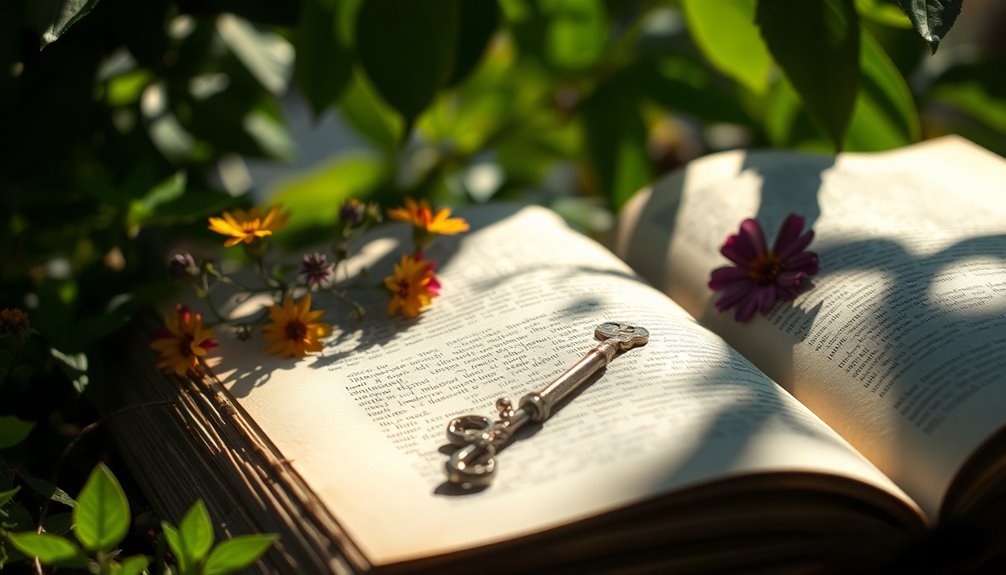
Recognizing symbolism in texts enhances your understanding of the narrative's deeper meanings. When you read, notice how the use of symbols can add layers to the story. For example, a character's green eyes might suggest jealousy rather than just being a physical trait. Authors often use repetition or striking imagery to hint at intentional symbolism, making you curious about the meaning behind the words. Some symbols are clear and easy to spot, like names that suggest certain traits. Others are more subtle and require a little digging to uncover their significance. It's a fun challenge! The use of symbolic representation allows authors to convey complex ideas and emotions in a nuanced way. Additionally, understanding the historical context of symbols can greatly enhance your interpretation of their significance.
However, be careful—too many obvious symbols can feel overwhelming, while overly subtle ones might confuse you. As you practice recognizing symbolism, you'll find that it enriches your reading experience. Just as in relationships, where strong communication skills are vital, understanding symbols can create a deeper connection with the text. You'll start to see how these symbols contribute to the themes and emotions of the text. So, keep an eye out for these hidden treasures! With each story, you'll grow more skilled at uncovering the deeper meanings, making your reading journey even more exciting. Happy reading!
Analyzing Symbolic Meanings
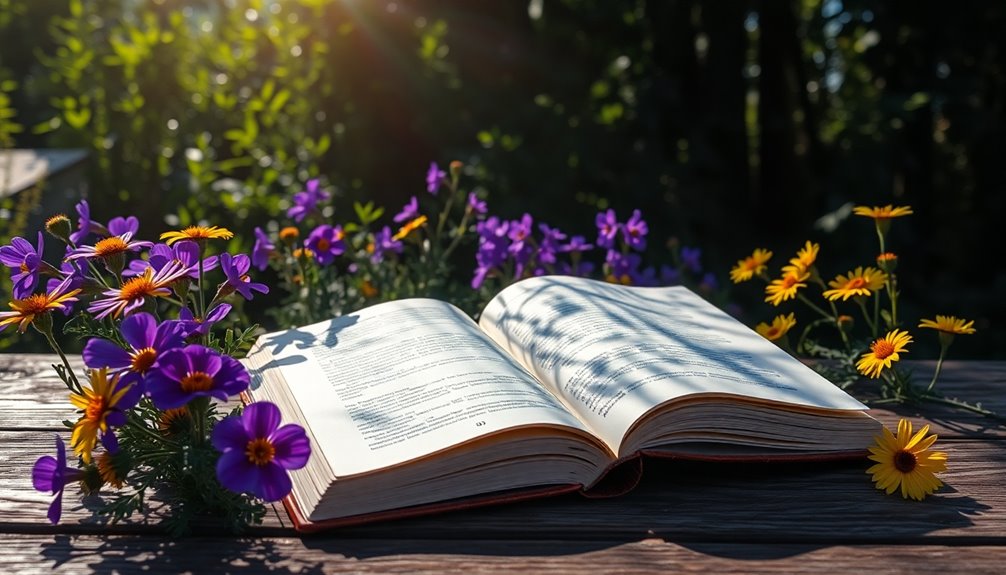
When you think about symbolism, it's not just in books; it's all around you in everyday life!
Different cultures have their own special meanings for symbols, like how a red rose often represents love.
Symbolism in Everyday Life
Although symbolism often goes unnoticed in our daily lives, it profoundly shapes how we perceive the world around us. You mightn't realize it, but objects and colors can represent something deeper.
For instance, red roses symbolize love and passion, while doves represent peace. These symbols evoke emotional responses and help us understand complex ideas.
Consider these everyday symbols:
- Wedding rings symbolize commitment and eternal love.
- Chains can signify oppression, reminding us of struggles.
- Blue skies often represent calmness and tranquility.
- Yellow lights may symbolize joy or caution, depending on where you see them.
Cultural Interpretations of Symbols
Symbols play a significant role not just in our everyday lives but also within various cultures, where their meanings can shift dramatically. You might notice, for example, that the color white is seen as pure in Western cultures but can mean mourning in some Eastern cultures. This shows how cultural interpretations of symbols can vary widely.
Think about animals, too! While doves usually symbolize peace everywhere, owls can send mixed messages. In some cultures, they're wise, but in others, they're seen as harbingers of death. Isn't that fascinating?
Even common objects can hold different meanings. The lotus flower symbolizes purity and enlightenment in Buddhism, but it mightn't have the same significance elsewhere.
Understanding these cultural interpretations is essential for clear communication. When you know what a symbol means in different cultures, it helps avoid misunderstandings. If you're ever unsure, asking questions can lead to deeper understanding.
Common Symbols and Their Interpretations

In literature, certain symbols carry universally recognized meanings that can enhance your understanding of a narrative. When you spot these common symbols, they can make the story more exciting and relatable.
Here are some symbols and their interpretations:
- Red roses: Love and romance
- Doves: Peace and tranquility
- Rainbows: Hope and promise
- Skulls: Mortality and the inevitability of death
These examples show how symbols can create powerful images in your mind.
But remember, cultural context can greatly influence how symbols are understood. For instance, the color yellow symbolizes joy in the U.S., but in Japan, it represents courage.
Recognizing these symbols helps you dive deeper into the story's message. They offer a way to connect with the characters and themes on a personal level.
Symbolism in Different Mediums
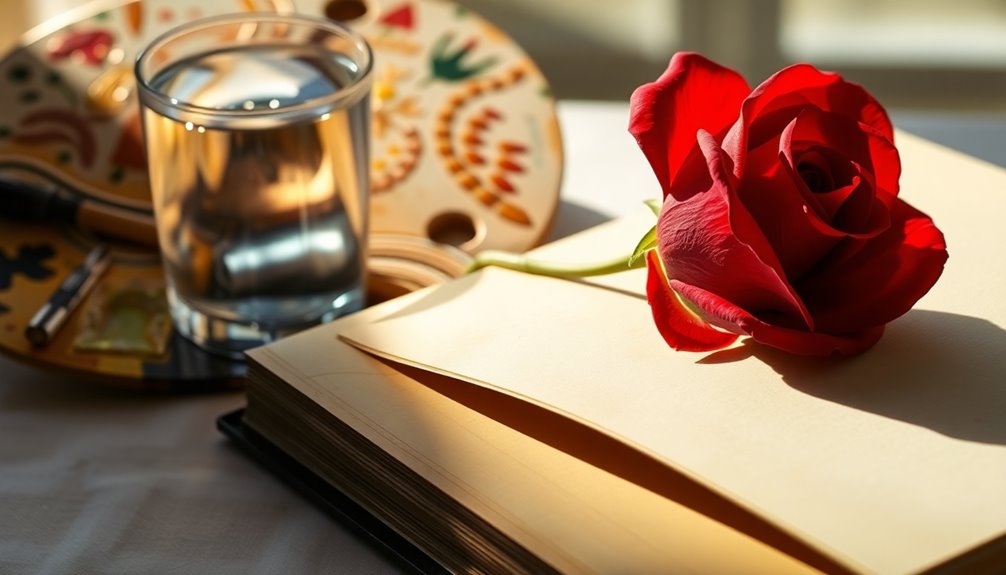
Recognizing the power of symbols goes beyond literature; they play a significant role in various mediums, each enhancing the narrative in unique ways.
In films, for instance, visual symbolism can deepen your understanding. Think of Orson Welles' "Rosebud" sled. It symbolizes lost innocence and adds depth to the story.
Speeches also use symbolism as a literary device. When John F. Kennedy spoke of hope in his inauguration speech, he inspired the nation with powerful symbols of renewal.
Art is another fascinating medium. Take Salvador Dalí's melting clocks in *The Persistence of Memory*. These clocks represent the fluidity of time and reality, inviting you to think deeply about existence.
In music, lyrics often incorporate rich symbolism. Bob Dylan's "Blowin' in the Wind" uses the wind to symbolize elusive truths and questions about social justice, engaging listeners in a profound conversation.
In each of these mediums, symbolism helps to convey abstract ideas, making them more relatable and understandable.
Enhancing Narrative Through Symbolism
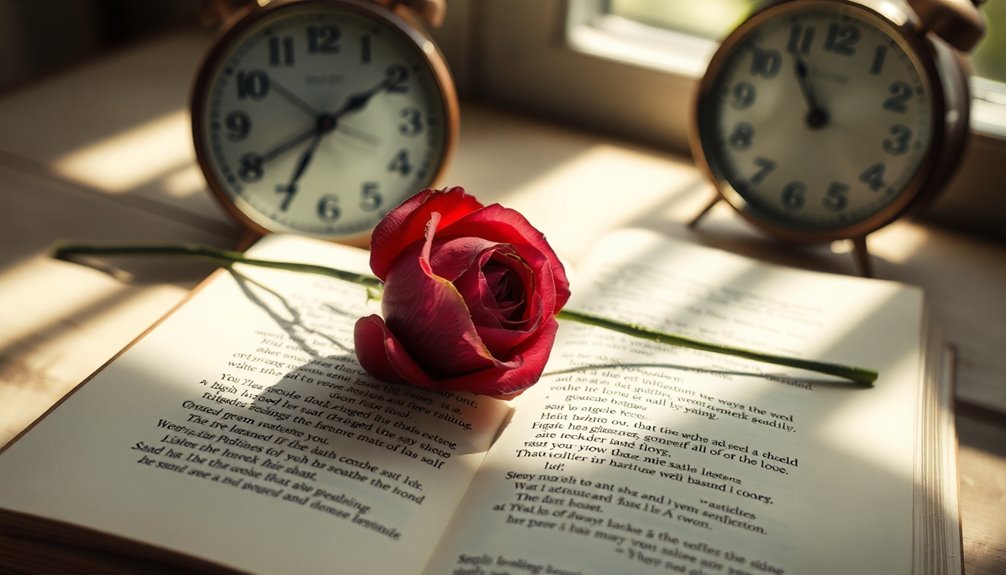
Through the clever use of symbolism, writers can elevate their narratives, allowing readers to connect deeply with complex themes and emotions.
When you read a story, you might notice special objects or actions that stand for bigger ideas. These symbols can enhance the narrative and add emotional depth that sticks with you long after you finish the book.
- A single drop of blood, representing guilt and ambition, like in Macbeth
- A green light across the water, shining with hope and dreams in The Great Gatsby
- A lightning bolt scar, marking Harry Potter's unique destiny and bravery.
- A stormy sky, reflecting a character's inner turmoil and struggles.
Frequently Asked Questions
Is Symbolism a Technique?
Yes, symbolism is a technique! It adds layers to stories by using objects or actions to represent bigger ideas.
When you read, you might notice a red rose standing for love or a storm representing trouble. These symbols help you connect more deeply with the characters and themes.
It's like a treasure hunt for meanings! So, next time you read, keep an eye out for those special symbols that make the story even richer!
Can Symbolism Be a Literary Device?
Symbolism can be a powerful literary device. Imagine a bright sun shining down, representing happiness, while a dark cloud brings feelings of sadness. This contrast helps you feel the story's emotions more deeply.
When authors use symbols, they give you clues about bigger ideas. For instance, a red rose might symbolize love, while a stormy sea could represent conflict.
It's exciting how these symbols can make stories come alive and resonate with you!
What Is an Example of Symbolism in Literary Techniques?
One great example of symbolism is the green light in *The Great Gatsby*. It stands for hope and dreams that seem just out of reach. When you read about it, you can feel the characters' longing and desire.
Another example is the mockingbird in *To Kill a Mockingbird*, which represents innocence.
These symbols help you understand deeper meanings in the stories, making your reading experience even more exciting and meaningful!
Is Symbolism a Figurative Language Technique?
You might think of symbolism like a treasure map, leading you to hidden meanings. It's not just words; it's the way objects or actions represent bigger ideas, too!
For example, a dove often symbolizes peace. When you spot these symbols, you're diving deeper into the story.
Conclusion
To sum up, symbolism is a fantastic tool that can make stories come alive! It helps you dive deeper into meanings and feelings, like texting your best friend about a movie's secret message. By using symbols, writers can connect with readers in exciting ways. So, whether you're reading or writing, keep an eye out for those hidden meanings. You might just discover a whole new world of imagination waiting for you. Happy exploring!


